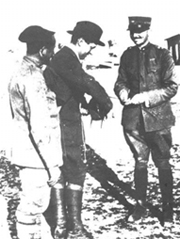In the last period of war 1915-1918 the Royal General Staff of the Army needed a laboratory to realize and maintain radio military materials. The laboratory, located in Viale Angelico (Rome), was at the dependencies of the 3rd Engineer Regiment and it was named Laboratory of Radiotelegraphic and Electronic Constructions of the Engineer Military Corps.
In the first post-war the Military Laboratory had to reorganize, repair and modernize the existent materials coming from the war area; later, between 1922 and 1926, it had to study new types of military field stations. By Royal Decree n. 451 of 20th April 1920 the Laboratory was named "Radiotelegraphic and Electronic Laboratory".

In 1927 the Laboratory was absorbed in the Engineer Specialists Service and in 1934 it passed at the dependencies of the Engineer Studies and Experiences Service with the name of Signals Military Laboratory (O.M.T.). Between the two wars, military engineers (such as Major Luigi SACCO) with world-renowned scientists (such as Guglielmo MARCONI) promoted development and production of radio equipment. In that period the O.M.T. became a modern laboratory of production with an organization that responded to the needs of a modern Army.
After the destructions by the German troops retreating, the O.M.T. suspended the production activity. After the liberation the reconstruction was started and in 1946 the 21st Engineer Military Establishment was constituted as executive body of the Engineer Service.
In 1949 the Establishment was named 21st Connections Establishment of the Military Engineer. Later its activities of study have been carried out by the Connections Centre (that corresponded to the Signal Military Technical Centre) and in 1953 it was named 21st Signals Establishment.
In 1967 the Establishment passed at the dependencies of the General Management of Weapons, Munitions and Land Armament. In 1978, after the reorganization of the Military Establishment and Arsenal, it was named Materials and Signals Military Establishment. In 1998 it assumed its present name of "Maintenance Centre of Electronic Telecommunication and Optoelectronic Means", passing from the Defence Industrial Area to the Operational Area and becoming an administrative Body led by a Brigadier General/Colonel of the Engineer Corps supported by a Deputy Chief. In 2001 the Centre had competences in the optic and opto-electronic sector.
Nowadays the Centre is at the dependencies of the Logistic Command of the Army, in particular of the Deputy Commander and Chief of the Transport and Material Unit; for territorial issue, it is at the dependencies of the Military Command; as regards the administrative sector, the technical connection is given by the Administrative Management of Florence.